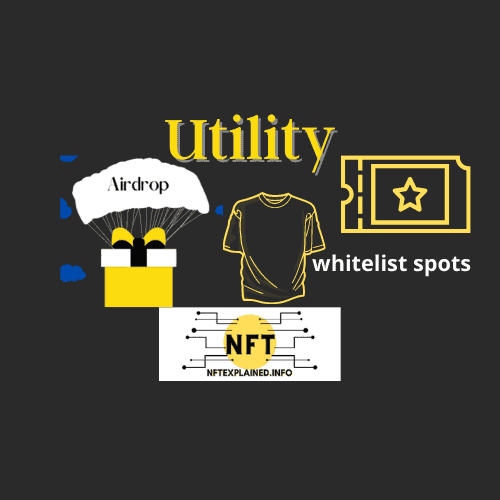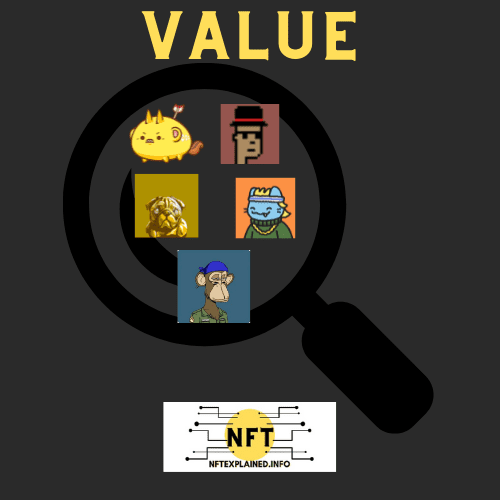
NFTs or non-fungible tokens are unique digital assets which can be verified to a single owner using the blockchain. NFTexplained.info is a team of long term crypto investors who have the goal of providing educational and informative information regarding the NFT space.
So what is utility in an NFT project? Let’s dive in!
Utility in NFTs refers to the benefits that come from owning an NFT, aside from the fact that it is a scarce digital item that can be bought and sold. Utility comes in a variety of forms – common examples include receiving physical goods, airdrops, future whitelist spots in new projects, and more.
The technology backing NFTs is what allows for verifiable ownership and therefore the fact that they can be bought and sold. The team at NFTexplained.info would not consider those aspects to be a form of utility given all NFTs have that ability already.
A common misconception is that the artwork itself is what uniquely causes an NFT project to be worth huge sums – even hundreds of thousands of dollars.
While artwork is a contributing factor, and the main value-driver for some NFTs, it is often the benefits that come from holding the NFT that drives up the price and the incentive to hold the NFT.
For example, holders of Bored Ape Yacht Club, an NFT collection many consider to be the most established, were given the utility of an airdrop. Bored Ape holders received (via airdrop) Mega Mutant serum for free; this serum was subsequently sold for up to 1,645 ETH or an astonishing US $6.2 million.
Next NFTexplained.info will analyze what makes an NFT valuable. We will also cover how utility is added to an NFT, the aspects needed to make a collection successful, and we will conclude our article by explaining what is meant by ‘utility’ status.
What Gives An NFT Value?

NFTs are valuable as they can be verified to a single owner; that owner also has the ability to sell the NFT. Aside from the value that comes from owning the digital art or music, NFTs are valuable because of the utility they provide – receiving physical items, access to real world events, and more.
NFT projects often have an incentive for people to hold the NFT long term because they act as a ticket; as a benefit for holding the NFT, you may be able to receive real world merchandise, attend concerts/events, the ability to mint new projects and more.
NFTs work using smart contracts and these smart contracts built into the NFT can represent virtually anything. As the team previously mentioned, these contracts may include, as an illustrative example, the ability to attend a real world concert.
Without holding the NFT you don’t have access to that smart contract and any of the benefits that help make the NFT valuable.
Without the utility of being able to attend events or receive future NFTs for free, people are less likely to purchase a JPG simply because they find it visually appealing; however, that is not always the case.
As NFTexplained.info previously mentioned there are some NFTs that are purchased simply because of the artwork; that being said, it’s likely a very small percentage of successful NFT projects.
How Do I Add Utility To An NFT?
Utility is made possible through the smart contract technology that NFTs have. This utility must be coded into the smart contract of the NFT. The utility can come in a vast variety of different ways – this may include an airdrop for future NFTs and more. Utility should be based around the buyer’s wants.
For those looking to create a successful NFT project, it is important to realize that utility can come in a multitude of different ways.
It is important to build utility based on what the intended purchaser would like. For example – a successful athlete could include utility like signed jerseys as this is something fans would enjoy.
A vast amount of utility is only successful if the project is being bought with the intention for a long term hold. This is important for investors to realize.
Purchasers with a ‘long term hold’ mindset have a conviction frequently borne from extended interaction with the project leads and the associated community as well as an appreciation for the project’s strong roadmap.
If a project is unsuccessful and being sold for far below the mint price, then being airdropped a new NFT will likely just be another JPG, sitting in MetaMask, that is worth close to nothing.
Since our team is discussing the success of an NFT project, this leads us to our next point.
How Do I Make My NFT Collection Successful?

There are a multitude of different aspects that go into play in order to make an NFT project successful. Understanding how the market works and how to create utility that will incentivize purchasers to hold long term are key ingredients for a successful NFT project.
Building a strong community and creating hype for the initial mint to sell out quickly is a promising sign of a successful project.
An engaged developing team that is accepting of critique and attempting to make the project successful is another promising sign.
If you are looking to invest in an NFT project, our team has made a guide of our top tips we would highly recommend you check out; that is linked here.
If the purchasers of a project are looking to make a quick flip or are simply purchasing the project as an attempt to make money, the project will likely not be successful.
The vast majority of people buying need to be holding for a long period of time; this will create high demand (as the developers and holders spread word of the project). This also creates scarcity which occurs when a limited number of people are willing to sell.
If you are interested in learning more about the economics behind an NFT, NFTexplained.info has a full article covering that, which can be found here.
As NFTexplained.info previously mentioned, knowing how to cater to holders or understanding what the buyers would want is key to success in an NFT project.
For example, a famous athlete (i.e. LaMelo Ball) who creates an NFT line would create utility based on the value brought since he/she is a professional athlete. This utility could be tickets to a game, signed merchandise, ability to talk to them, and more.
Utility that may not be as appealing is receiving whitelist spots for another NFT project as it doesn’t bring much value related to the core reason as to what inherently makes this person’s NFT project different from that of an anonymous person.
Finally, NFTexplained.info will conclude our article by explaining the ‘utility’ status on OpenSea.
What Are NFTs With A ‘Utility’ Status?
NFTs that bring additional value aside from scarcity can be classified as utility NFTs. Utility NFTs can be considered as NFTs that provide additional perks. OpenSea uses the term utility NFTs; this can be confusing as a single NFT can straddle in multiple categories – a collectible can also have utility.
The utility category is a way for OpenSea to help in categorizing the numerous NFTs that are listed.
The ‘utility’ status created by OpenSea can be considered more of a subjective term as it can be argued that a single NFT collection can be classified or put in numerous categories like both utility and collectibles.

We hope you are just as excited as we are about NFTs and continue to stay informed at NFTexplained.info. To get the latest news in this rapidly evolving space, follow our team on Instagram & Twitter!
